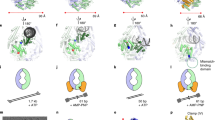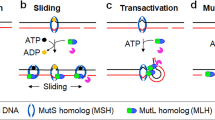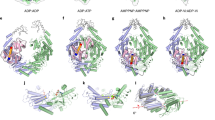Abstract
DNA mismatch repair ensures genomic integrity on DNA replication. Recognition of a DNA mismatch by a dimeric MutS protein initiates a cascade of reactions and results in repair of the newly synthesized strand; however, details of the molecular mechanism remain controversial. Here we present the crystal structure at 2.2 Å of MutS from Escherichia coli bound to a G·T mismatch. The two MutS monomers have different conformations and form a heterodimer at the structural level. Only one monomer recognizes the mismatch specifically and has ADP bound. Mismatch recognition occurs by extensive minor groove interactions causing unusual base pairing and kinking of the DNA. Nonspecific major groove DNA-binding domains from both monomers embrace the DNA in a clamp-like structure. The interleaved nucleotide-binding sites are located far from the DNA. Mutations in human MutSα (MSH2/MSH6) that lead to hereditary predisposition for cancer, such as hereditary non-polyposis colorectal cancer, can be mapped to this crystal structure.
This is a preview of subscription content, access via your institution
Access options
Subscribe to this journal
Receive 51 print issues and online access
$199.00 per year
only $3.90 per issue
Buy this article
- Purchase on Springer Link
- Instant access to full article PDF
Prices may be subject to local taxes which are calculated during checkout




Similar content being viewed by others
References
Modrich, P. & Lahue, R. Mismatch repair in replication fidelity, genetic recombination, and cancer biology. Annu. Rev. Biochem. 65, 101–133 ( 1996).
Kolodner, R. D. & Marsischky, G. T. Eukaryotic DNA mismatch repair. Curr. Opin. Genet. Dev. 9, 89–96 (1999).
Buermeyer, A. B., Deschenes, S. M., Baker, S. M. & Liskay, R. M. Mammalian DNA mismatch repair. Annu. Rev. Genet. 33 , 533–564 (1999).
Su, S. S., Lahue, R. S., Au, K. G. & Modrich, P. Mispair specificity of methyl-directed DNA mismatch correction in vitro. J. Biol. Chem. 263, 6829–6835 (1988).
Joshi, A., Sen, S. & Rao, B.J. ATP-hydrolysis-dependent conformational switch modulates the stability of MutS-mismatch complexes. Nucleic Acids Res. 28, 853–861 (2000).
Biswas, I. & Vijayvargia, R. Heteroduplex DNA and ATP induced conformational changes of a MutS mismatch repair protein from Thermus aquaticus . Biochem. J. 347, 881– 886 (2000).
Allen, D. J. et al. MutS mediates heteroduplex loop formation by a translocation mechanism. EMBO J. 16, 4467– 4476 (1997).
Blackwell, L. J., Bjornson, K. P. & Modrich, P. DNA-dependent activation of the hMutSα ATPase. J. Biol. Chem. 273, 32049– 32054 (1998).
Blackwell, L. J., Martik, D., Bjornson, K. P., Bjornson, E. S. & Modrich, P. Nucleotide-promoted release of hMutSα from heteroduplex DNA is consistent with an ATP-dependent translocation mechanism. J. Biol. Chem. 273, 32055– 32062 (1998).
Bjornson, K. P., Allen, D. J. & Modrich, P. Modulation of MutS ATP hydrolysis by DNA cofactors. Biochemistry 39, 3176– 3183 (2000).
Gradia, S., Acharya, S. & Fishel, R. The human mismatch-recognition complex hMSH2–hMSH6 functions as a novel molecular switch. Cell 91, 995–1005 (1997).
Gradia, S. et al. hMSH2–hMSH6 forms a hydrolysis-independent sliding clamp on mismatched DNA. Mol. Cell 3, 255– 261 (1999).
Gradia, S., Acharya, S. & Fishel, R. The role of mismatched nucleotides in activating the hMSH2–hMSH6 molecular switch. J. Biol. Chem. 275, 3922–2930, (2000).
Galio, L., Bouquet, C. & Brooks, P. ATP hydrolysis-dependent formation of a dynamic ternary nucleoprotein complex with MutS and MutL. Nucleic Acids Res. 27, 2325–2331 (1999).
Ban, C. & Yang, W. Crystal structure and ATPase activity of MutL: implications for DNA repair and mutagenesis. Cell 95, 541–552 (1998).
Ban, C., Junop, M. & Yang, W. Transformation of MutL by ATP binding and hydrolysis: a switch in DNA mismatch repair. Cell 97, 85–97 (1999).
Lynch, H. T. & De La Chapelle, A. Genetic susceptibility to non-polyposis colorectal cancer. J. Med. Genet. 36, 801–181 (1999).
Vogelstein, B. & Kinzler, K.W. The multistep nature of cancer. Trends Genet. 9, 138– 141 (1993).
Takamatsu, S., Kato, R. & Kuramitsu, S. Mismatch DNA recognition protein from an extremely thermophilic bacterium, Thermus thermophilus HB8. Nucleic Acids Res. 24, 640–647 ( 1996).
Biswas, I. et al. Oligomerization of a MutS mismatch repair protein from Thermus aquaticus. J. Biol. Chem. 274, 23673–23678 (1999).
Holm, L. & Sander, C. Dali/FSSP classification of three-dimensional protein folds. Nucleic Acids Res. 25, 231 –234 (1997).
Li, H., Trotta, C. R. & Abelson, J. Crystal structure and evolution of a transfer RNA splicing enzyme. Science 280, 279– 284 (1998).
Ariyoshi, M. et al. Atomic structure of the RuvC resolvase: a Holliday junction-specific endonuclease from E. coli. Cell 78, 1063–1072 (1994).
Hung, L. W. et al. Crystal structure of the ATP-binding subunit of an ABC transporter. Nature 396, 703–707 (1998).
Lavery, R. & Sklenar, H. Defining the structure of irregular nucleic acids: conventions and principles. J. Biomol. Struct. Dyn. 6, 655–667 ( 1989).
Hunter, W. N. Crystallographic studies of DNA containing mismatches, modified and unpaired bases. Methods Enzymol. 211, 221– 231 (1992).
Tsutakawa, S. E., Jingami, H. & Morikawa, K. Recognition of a TG mismatch: the crystal structure of very short patch repair endonuclease in complex with a DNA duplex. Cell 99, 615–623 ( 1999).
Malkov, V. A., Biswas, I., Camerini-Otero, R. D. & Hsieh, P. Photocross-linking of the NH2-terminal region of Taq MutS protein to the major groove of a heteroduplex DNA. J. Biol. Chem. 272, 23811–23817 (1997).
Marra, G. & Schar, P. Recognition of DNA alterations by the mismatch repair system. Biochem. J. 338, 1–13 (1999).
Hayward, S. & Berendsen, H. J. C. Systematic analysis of domain motions in proteins from conformational change; new results on citrate synthase and T4 lysozyme. Proteins Struct. Funct. Genet. 30, 144–154 (1998).
Sprang, S. R. G protein mechanisms: insights from structural analysis. Annu. Rev. Biochem. 66, 639–678 (1997).
Gerstein, M., Schulz, G. & Chothia, C. Domain closure in adenylate kinase. Joints on either side of two helices close like neighboring fingers. J. Mol. Biol. 229, 494–501 ( 1993).
Iaccarino, I., Marra, G., Palombo, F. & Jiricny, J. hMSH2 and hMSH6 play distinct roles in mismatch binding and contribute differently to the ATPase activity of hMutSα. EMBO J. 17, 2677–2686 (1998).
Studamire, B., Quach, T. & Alani, E. Saccharomyces cerevisiae Msh2p and Msh6p ATPase activities are both required during mismatch repair. Mol. Cell. Biol. 18, 7590–7601 ( 1998).
Iaccarino, I., Marra, G., Dufner, P. & Jiricny, J. Mutation in the magnesium binding site of hMSH6 disables the hMutSα sliding clamp from translocating along DNA. J. Biol. Chem. 275, 2080–2086 (2000).
Habraken, Y., Sung, P., Prakash, L. & Prakash, S. ATP-dependent assembly of a ternary complex consisting of a DNA mismatch and the yeast MSH2–MSH6 and MLH1–PMS1 protein complexes. J. Biol. Chem. 273, 9837–9841 (1998).
Wu, T. H. & Marinus, M. G. Deletion mutation analysis of the mutS gene in Escherichia coli. J. Biol. Chem. 274, 5948–5952 (1999).
Su, S. S. & Modrich, P. Escherichia coli mutS-encoded protein binds to mismatched DNA base pairs. Proc. Natl. Acad. Sci. USA 83, 5057–5061 ( 1986).
Panuska, J. R. & Goldthwait, D. A. A DNA-dependent ATPase from T4-infected Escherichia coli. Purification and properties of a 63,000-dalton enzyme and its conversion to a 22,000-dalton form. J. Biol. Chem. 255 5208–5214 (1980).
Fishel, R. A., Siegel, E. C. & Kolodner, R. Gene conversion in Escherichia coli. Resolution of heteroallelic mismatched nucleotides by co-repair. J. Mol. Biol. 188, 147–157 ( 1986).
Otwinowski, Z. & Minor, W. Processing of X-ray diffraction data collected in oscillation mode. Methods Enzymol. 276, 307–326 ( 1997).
Weeks, C. M. & Miller, R. The design and implementation of SnB v2.0. J. Appl. Crystallogr. 32, 120– 124 (1999).
Collaborative Computational Project Number 4. The CCP4 suite: programs for protein crystallography. Acta Crystallogr. D 50, 760–763 (1994).
La Fortelle, E. de & Bricogne, G. Maximum-likelihood heavy-atom parameter refinement in the MIR and MAD methods. Methods Enzymol. 276, 472–494 ( 1997).
Jones, T. A., Zou, J-Y., Cowan, S. W. & Kjeldgaard, M. Improved methods for building protein models in electron density maps and the location of errors in these models. Acta Crystallogr. A 47, 110–119 (1991)
Brünger, A. T. et al. Crystallography & NMR system: A new software suite for macromolecular structure determination. Acta Crystallogr. D 54, 905–921 (1998).
Murshudov, G. N., Vagin, A. A. & Dodson, E. J. Refinement of macromolecular structures by the maximum-likelihood method. Acta Crystallogr. D. 53, 240– 255 (1997).
Nicholls, A., Sharp, K. A. & Honig, B. Protein folding and association: insights from the interfacial and thermodynamic properties of hydrocarbons. Proteins Struct. Funct. Genet. 11, 281–296 (1991).
Gouet, P., Courcelle, E., Stuart, D. I. & Metoz, F. ESPript: analysis of multiple sequence alignments in PostScript. Bioinformatics. 15, 305–308 (1999).
Culligan, K. M., Meyer-Gauen, G., Lyons-Weiler, J. & Hays, J. B. Evolutionary origin, diversification and specialization of eukaryotic MutS homolog mismatch repair proteins. Nucleic Acids Res. 28, 463–471 (2000).
Acknowledgements
We thank M. Marinus for MutS plasmid pMQ372 and purification protocols; P. Modrich for strain RK1517; S. Cusack and H. te Riele for support and enthusiasm; J. Tainer for useful suggestions; G. Sheldrick for discussions on twinning; C. Vonrhein for assistance with SHARP; K. Culligan and J. Hays for use of their alignment; and staff at the ESRF and EMBL outstations Hamburg and Grenoble, in particular G. Leonard, for support in data collection. This work was supported by the Dutch Cancer Society and an EMBO post-doctoral fellowship to A.P., and by European Union TMR/LSF grants for data collection visits.
Author information
Authors and Affiliations
Corresponding author
Rights and permissions
About this article
Cite this article
Lamers, M., Perrakis, A., Enzlin, J. et al. The crystal structure of DNA mismatch repair protein MutS binding to a G·T mismatch. Nature 407, 711–717 (2000). https://doi.org/10.1038/35037523
Received:
Accepted:
Issue Date:
DOI: https://doi.org/10.1038/35037523
This article is cited by
-
Quantitative proteomics and in-cell cross-linking reveal cellular reorganisation during early neuronal differentiation of SH-SY5Y cells
Communications Biology (2022)
-
Tandem regulation of MutS activity by ATP and DNA during MMR initiation
Nature Structural & Molecular Biology (2022)
-
MutS and MutL sliding clamps in DNA mismatch repair
Genome Instability & Disease (2022)
-
Mispair-bound human MutS–MutL complex triggers DNA incisions and activates mismatch repair
Cell Research (2021)
-
The selection process of licensing a DNA mismatch for repair
Nature Structural & Molecular Biology (2021)
Comments
By submitting a comment you agree to abide by our Terms and Community Guidelines. If you find something abusive or that does not comply with our terms or guidelines please flag it as inappropriate.



